How a sand battery could transform clean energy
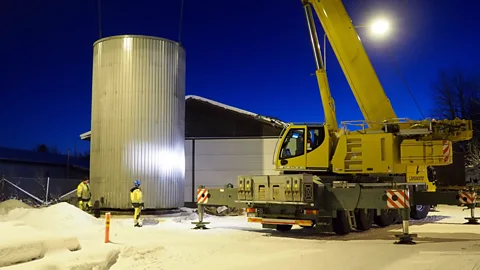 Polar Night Energy
Polar Night EnergyA new way of storing renewable energy is providing clean heat through the long Nordic nights.
At the end of a winding, tree-lined country road in western Finland, four young engineers believe they have a possible answer to one of green energy's biggest challenges.
The challenge is how to provide a year-round, steady power supply from renewable energy during changing seasons and variable weather conditions. The answer nestling in Vatajankoski power plant, 270 km (168 miles) north-west of Finland's capital, Helsinki, is remarkably simple, abundant and cheap: sand.
The Vatajankoski power plant is home to the world's first commercial-scale sand battery. Fully enclosed in a 7m (23ft)-high steel container, the battery consists of 100 tonnes of low-grade builders' sand, two district heating pipes and a fan. The sand becomes a battery after it is heated up to 600C using electricity generated by wind turbines and solar panels in Finland, brought by Vatajankoski, the owners of the power plant.
The renewable energy powers a resistance heater which heats up the air inside the sand. Inside the battery, this hot air is circulated by a fan around the sand through heat exchange pipes.
Thick insulation surrounds the sand, keeping the temperature inside the battery at 600C (1,112F), even when it is freezing outside. "We don't want to lose any heat; the average winter temperature is below 0C (32F) in Kankanpää," says Ville Kivioja, lead scientist at Polar Night Energy, who monitors the battery's performance online.
The battery stores 8 MWh of thermal energy when full. When energy demand rises, the battery discharges about 200 kW of power through the heat-exchange pipes: that's enough to provide heating and hot water for about 100 homes and a public swimming pool in Kankaanpää, supplementing power from the grid. The battery is charged overnight when the electricity prices are lower.
It's a low-maintenance system, says Kivioja. The company uses cheap, low-quality sand that's been rejected by builders instead of high quality river-sand which is used in vast quantities for construction, leading to a global shortage.
"There's no wear and tear involved with the [heat exchange] pipes and the sand. The fan is the only moving part and it's easy to replace if necessary," says Kivioja.
Sand is a very effective medium for retaining heat over a long period, storing power for months at a time. And there are other benefits too. "The sand has a very long lifetime: it can heat up and cool off any number of times," says Kivioja. "It will get denser after a while so needs less space. At that point we can add more sand."
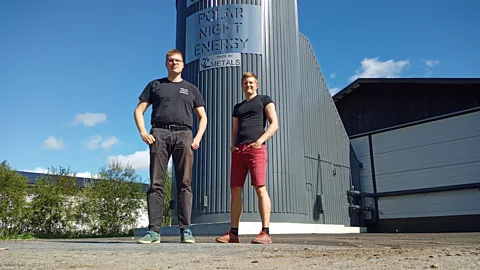 Polar Night Energy
Polar Night EnergyThe four young Finnish engineers who invented this sand battery go back a long way. Tommi Eronen, Markku Ylönen, Liisa Naskali and Ville Kivioja bonded as children over a shared passion for athletics. The sprinter, cyclist, triple jumper and discus thrower belonged to the same club in Tampere, southern Finland, cheering each other on at track and field events during their teenage years.
As they entered their twenties, their interests turned from sport to science. Shorter and warmer winters in the south of Finland sparked a shared motivation to tackle climate change.
"The number of days of ice cover on Näsijärvi, the lake where we used to skate as children, has decreased dramatically in the last few years. Climate change is happening in front of our eyes," says Eronen.
You might also like:
In 2016, while doing research for his engineering Master's degree, Eronen was looking into water-based storage systems for renewable energy. But while reading an article about traditional Finnish fireplaces, made from stone and sand, Eronen had a lightbulb moment.
"It got me thinking: would a solid material, rather than water, be more suitable for storing solar and wind energy?" Eronen says.
The search for steady supply
The production of wind and solar energy depends on the weather and seasons and is therefore variable. This means energy production doesn't always match energy demand.
This makes the lack of cheap, viable and sustainable storage technologies one of the biggest barriers to switching the world from fossil fuels to renewable sources of energy.
"Storing renewables is one of the most important challenges we have to meet to achieve the target of net zero CO2 emissions by 2050, which the UN's Intergovernmental Panel on Climate Change (IPCC) says is crucial in order to limit global warming to 1.5C," says Yulong Ding, director of the Birmingham Centre for Energy Storage in the UK.
Together with Ylönen, he started developing the sand battery prototype. Having successfully tested their pilot battery in Eronen's grandfather's garden near Tampere, the pair recruited their childhood friends from the athletics club to start Polar Night Energy. In July, they installed the first commercial sand battery at the Vatajankoski power plant in Kankaanpää.
Storing green energy
The innovation has generated a flurry of excitement around the globe. "My phone is constantly ringing and I have thousands of unread emails," says Eronen.
A small commercial application of a new energy storage system rarely becomes a hot topic, but the sand battery has attracted attention for its potential to even out the power supply from renewable sources (see The search for steady supply box).
Viable storage of solar and wind energy is especially critical for Nordic countries which have long hours of darkness and an increased need for heat in the winter, but extended hours of sunlight in the summer.
In the wake of the Ukraine war, Finland is urging the EU to increase its renewables output. "The only way out of the energy crisis is to invest heavily in renewable and emission-free energy production," Finland's prime minister Sanna Marin said in September.
The sand battery's inventors hope that this is where their solution comes in.
"My first thought was 'why didn’t I think of that?'" laughs Eva Pongrácz, vice-head of the water, energy and environmental engineering research unit at the University of Oulu in northern Finland. "Such a simple, fresh and innovative idea. Could this be the solution for the continuous supply of green energy? I don't think there will be one single answer but this is part of the solution."
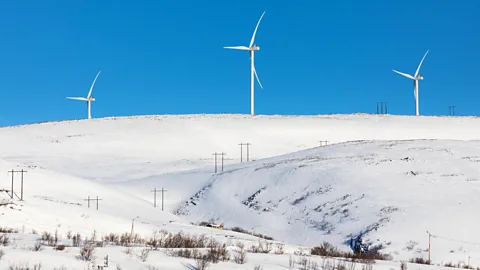 Getty Images
Getty ImagesBut how exactly does the battery stand up in terms of performance compared with other batteries, in particular its electrochemical counterpart: lithium-ion batteries?
One big problem with lithium-ion batteries, which we use to power our laptops, phones and electric vehicles, is that they continuously degrade, even when they are not in use, says Pongrácz. "There's no chemical reaction in sand batteries so they don't go through a similar process of ageing," says Pongrácz.
Lithium batteries are not suitable for large-scale storage applications, says Yulong Ding, director of the Birmingham Centre for Energy Storage in the UK, adding that they are also inherently flammable.
Then there are the environmental concerns. "Lithium has a much bigger environmental impact than sand," says Pongrácz. For every tonne of refined lithium produced, the equivalent of between around three and nine tonnes of CO2 is emitted, depending on how it is extracted.
But the Polar Night Energy team face some big challenges: can they scale up their technology to really make a difference and can they use it to generate significant amounts of electricity in addition to heat?
There are of course limitations, experts note. "A sand battery stores five to 10 times less energy [per unit volume] than traditional chemical batteries," says Dan Gladwin from the department of electronic and electrical engineering at the University of Sheffield in the UK.
The Polar Night Energy team acknowledges this but argues that a sand battery is a far more cost-effective solution. The team has calculated that their battery is eight to 10 times cheaper than a lithium battery which stores the same amount of energy. To generate 8 MWh of energy using the Kankaanpää sand battery costs about $200,000 (£174,000), says Eronen. A lithium-ion battery storing 8 MWh of energy would cost at least $1,600,000 (£1,391,000), he says.
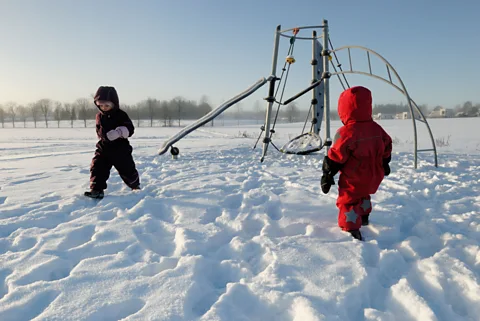 Alamy
AlamyGladwin says the sand battery is great for heating houses in countries with a cold climate, but warns that the efficiency drops off when it is used to return power to the electricity grid.
"To make it more widely useable, they'd need to develop a way of converting the battery's heat back to electricity with 75-80% efficiency. That would make it a game changer," he says.
Eronen says that with currently available technology the process of converting heat back into electricity only has an efficiency rate of 30%. But he doesn't view that as a major issue. "In a cold country like Finland we're dumping 70% of the heat that remains after conversion on the district heating networks that needs a supply of heat almost all the time," he says.
The next step in scaling up the battery for electricity generation is adding a turbine to convert heat back to the grid. "In a couple of years we'll have a working system to do just that," says Eronen.
Polar Night Energy is in the process of signing a contract to build a second battery for another district heating company in Finland.
"This is for a significantly bigger system: 2MW in heating power and 500MWh in storage capacity. That's 10 times bigger than what we have in Kankaanpää," says Eronen.
At the moment, the sand battery remains a Nordic solution at heart, says Pongrácz. "It's very useful in Finland where we have cold winters and need heating pretty much from September to May, [due to] an average annual temperature of under 10C (50F)," she says, adding that half of Finland's 5.5 million people are connected to a district heating network.
But in theory the energy storage solution could be replicated anywhere in the world where there is district heating infrastructure, including New York, San Francisco and Copenhagen.
"It has far more potential [beyond] heating houses anyway," says the company's project manager, Liisa Naskali. "When scaled up, it will be available for use in all kinds of industrial processes that require high heat: bakeries, laundries [and] steelworks."
Eronen says that by 2023 Polar Night Energy aims to be "a truly global company, constructing sand batteries all over the world". The huge boom in offshore wind power – by 2025 wind energy will cover 25% of Finland's electricity consumption - will help enable this, but there is still "a lot of work to do".
"We'll need enormous storage capacities to balance the fluctuations in production," he says.
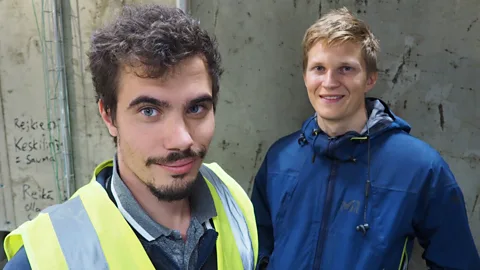 Polar Night Energy
Polar Night EnergyTo aid international expansion plans, Polar Night Energy is looking at replacing sand with other granular, non-flammable materials in places where there's a shortage of sand. "The idea is to look around and find a suitable material locally: we can for example test by-products of industrial processes and see if we can use them," says Eronen.
By far the biggest challenge to expansion is companies' and municipalities' reluctance to invest in new technologies. "In Finland, district heating companies have service obligations to supply heat and they have to pay a penalty if they fail to meet those obligations. That's why they prefer to err on the side of caution before approving a big investment in a novel technology," says Naskali.
Carbon Count
The emissions from travel it took to report this story were 70kg CO2. The digital emissions from this story are an estimated 1.2g to 3.6g CO2 per page view. Find out more about how we calculated this figure here.
Finnish energy company Vatajankoski is an exception. "We want to find ways to fight climate change. We were looking at technologies for how to produce heat without burning fossil fuels and came across Polar Night Energy… It's a robust technology," says Pekka Passi, Vatajankosi's managing director who, like Naskali, believes that the battery's biggest potential is in industrial use.
"Some industries need very hot air, 300C (572F), for drying something, for example. We are now looking at cooperating with industrial companies in the Kankaanpää area that use electricity to produce heat. Having a sand battery that they can charge overnight would give them flexibility and shield them from price fluctuations," he says.
Pointing to the extreme temperatures, drought and wildfires engulfing the world, the young Finnish engineers say we don't have the luxury of waiting to switch to new technologies. "We need to take brave decisions now in order to avoid the [climate] crisis," says Kivioja.
"There's a lot of pressure on us scientists and engineers to sort climate change," he says. "I turn that pressure into inspiration, just like I did when I was competing at discus throwing. When you're there in the field, preparing for the next throw, you can't freeze under pressure. I bring the same attitude to my job."
Eronen says that "starting a company is a bit like competing in sport: you want to win". Together with Ylönen, he chose to cycle 170km (106 miles) from their home town of Tampere to attend an energy conference in Helsinki in 2018. "All the other participants arrived by car or plane. That made us think: 'we really have to make an impact'."
* You can now listen to more about Erika Benke's visit to the Vatajankoski power plant in this podcast by our colleagues on The Climate Question.
--
This article was amended on 4/11/22 to clarify a quote from Yulong Ding.
--
